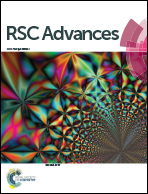Penicacids H–J, three new mycophenolic acid derivatives from the marine-derived fungus Rhizopus oryzae†
Abstract
Chemical investigation of secondary metabolites in crude methanol extract of a solid rice medium of a marine-derived fungus, Rhizopus oryzae, has enriched the metabolic profile of this genus by affording three mycophenolic acid derivatives recognized as new fungal metabolites trivially named as penicacids H–J (1–3), along with two known naphtho-γ-pyrone dimers, asperpyrone A (4) and dianhydroaurasperone C (5). Structure elucidation of isolated compounds was unambiguously determined based on extensive 1D and 2D NMR spectroscopic analyses together with comparing coupling constant and optical rotation values with those reported for related congeners in literature. All isolated compounds were assessed for their antibacterial activity against four different bacterial microorganisms and they revealed moderate to weak activities with minimum inhibitory concentration (MIC) values ranging from 62.5 to 250 μg mL−1.



 Please wait while we load your content...
Please wait while we load your content...